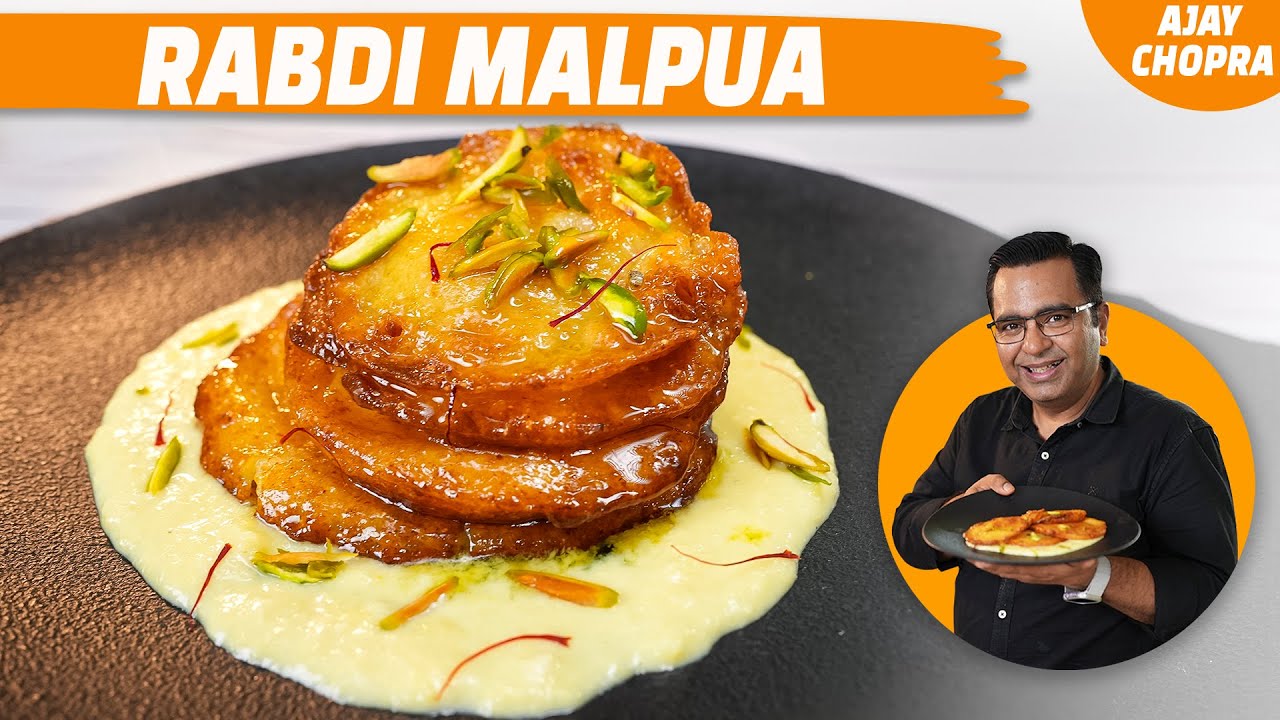
Rabdi Malpua Recipe

50 Mins

4-5 People

10 Mins
Introduction:
There's something truly magical about the rich, creamy sweetness of Rabdi Malpua that never fails to transport me back to my childhood days. I vividly remember visiting my grandmother's house during festivals, eagerly awaiting the moment when she would bring out a plateful of these delectable treats. The warm aroma of fried malpuas dipped in fragrant rabdi would fill the air, and every bite would melt in my mouth, leaving behind an unforgettable taste. This traditional dessert holds a special place in my heart, symbolizing love, tradition, and the joy of indulging in simple pleasures.
Recipe of Rabdi Malpua
Ingredients:
For Sugar Syrup/Chasni:
- 1 cup Sugar
- ½ cup Water
- 7-8 strands Saffron (Kesar)
- 3-4 Green Cardamom Pods
For Rabdi Mixture:
- 1 litre Milk
- 4 slices Bread
- 1 small bowl Refined Flour
- 1 tbsp Semolina (Suji)
- 3-4 tbsp Milk
- 3 tbsp Sugar
- 8-9 strands Saffron (Kesar)
- ½ tbsp Kewra Water
For Malpua:
- Prepared Rabdi Mixture
- Ghee (for frying)
Method
For Sugar Syrup (Chasni):
- In a pan, combine sugar and water.
- Heat the mixture until the sugar dissolves.
- Add saffron strands and crushed green cardamom pods.
- Simmer until the syrup thickens slightly. Set aside.
For Rabdi Mixture:
- In a separate pan, bring milk to a simmer.
- Let the milk reduce by more than half its original volume.
- Remove the edges of bread slices and pulse them into crumbs.
- Add bread crumbs to the reduced milk and cook for 4-5 minutes.
- Let the Rabdi mixture cool.
For Malpua:
- Take half of the prepared Rabdi mixture in a bowl.
- Add semolina, refined flour, sugar, and milk. Mix into a smooth batter.
- Heat ghee in a pan and pour a portion of the batter.
- Cook until golden brown on both sides.
- Remove from the pan and soak in the prepared sugar syrup for 4-5 minutes.
Assembling:
- Prepare the remaining Rabdi mixture by adding saffron, kewra water, and sugar.
- Arrange the soaked Malpuas on a serving plate.
- Pour Rabdi generously over the Malpuas.
- Garnish with finely chopped pistachios.
- Serve warm and enjoy!
About the Recipe:
Rabdi Malpua is a classic Indian dessert that consists of two main components: malpua and rabdi. Malpua is a sweet pancake made from a batter of flour, milk, and sugar, which is deep-fried until golden brown. Rabdi, on the other hand, is a thickened milk-based dessert flavored with cardamom, saffron, and sugar. The malpuas are soaked in sugar syrup and then served with a generous drizzle of rabdi, creating a heavenly combination of flavors and textures.
Cooking Tips:
- Use full-fat milk to make rabdi for a rich and creamy texture.
- Add a pinch of saffron strands to the rabdi for a beautiful color and exotic flavor.
- Ensure that the malpua batter is thick enough to hold its shape when fried, but not too thick that it becomes doughy.
- Fry the malpuas on medium heat until they are golden brown and crispy on the edges.
- Soak the fried malpuas in sugar syrup for at least 2-3 minutes to ensure they are moist and sweet.
- Serve Rabdi Malpua warm for the best taste and texture.
Pairing Guide:
Rabdi Malpua pairs well with a variety of accompaniments such as chopped nuts, dried fruits, or a scoop of vanilla ice cream for added indulgence.
Frequently Asked Questions (FAQs) about Rabdi Malpua:
-
What is Rabdi Malpua? Rabdi Malpua is a traditional Indian dessert consisting of deep-fried pancakes (malpua) served with thickened sweetened milk (rabdi).
-
How do you make Rabdi for Malpua? To make rabdi for malpua, simmer full-fat milk until it thickens, then add sugar, cardamom, and saffron for flavor.
-
What is Malpua made of? Malpua is made from a batter of flour, milk, sugar, and sometimes mashed ripe bananas or khoya (reduced milk solids).
-
Can I make Rabdi Malpua without frying? While traditionally malpua is deep-fried, you can try shallow frying or baking them for a healthier version.
-
How do you serve Rabdi Malpua? Rabdi Malpua is typically served by soaking the fried malpuas in sugar syrup and then serving them with a generous drizzle of rabdi.
-
Can I make Rabdi Malpua in advance? Yes, you can make both the malpuas and rabdi in advance and assemble them just before serving.
-
Is Rabdi Malpua gluten-free? Malpua made with gluten-free flour can be gluten-free, but always check the ingredients to ensure they are suitable for a gluten-free diet.
-
How long does Rabdi Malpua last? Rabdi Malpua is best enjoyed fresh, but leftovers can be stored in the refrigerator for up to 2-3 days.
-
Can I reheat Rabdi Malpua? Yes, you can reheat Rabdi Malpua in the microwave or oven until warm before serving.
-
What are some variations of Rabdi Malpua? Some variations of Rabdi Malpua include adding nuts, fruits, or spices to the malpua batter, or experimenting with different flavors in the rabdi, such as rose water or pistachios.
